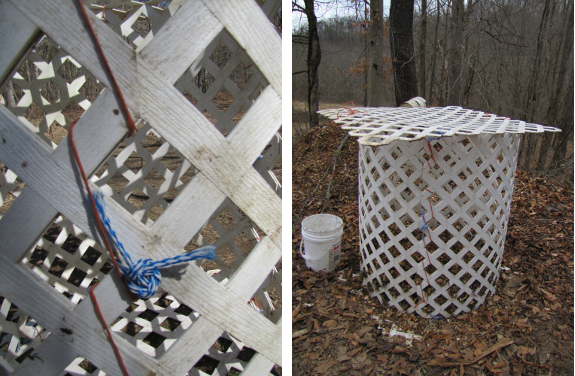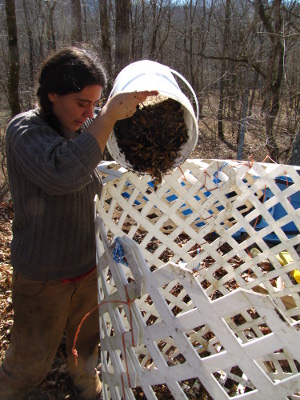
Homemade trellis panel compost bin

Although I would love to
be giving
every bit of the local school's food waste to the worms, I don't want to overload
the bin, so I needed to come up with some kind of critter-proof compost
bin to take care of the excess. I settled on a simple (and free)
design using vinyl lattice trellis panels Mark's mom found for us on
the side of the road (thanks, Rose Nell!) tied together with the
plastic baling twine they now use to bind up strawbales. I also
used a few pieces of rope that Rose Nell got us for free when a rope
factory went out of business.
 While
my bin wouldn't stand up to steady
gnawing from Lucy,
once I laid down a thick layer of wood chips inside, tossed in the
excess scraps, and topped it all off with another layer of wood chips,
the bin became so unappealing that our dog didn't even give it a second
glance. Hopefully wild animals will be similarly uninterested.
While
my bin wouldn't stand up to steady
gnawing from Lucy,
once I laid down a thick layer of wood chips inside, tossed in the
excess scraps, and topped it all off with another layer of wood chips,
the bin became so unappealing that our dog didn't even give it a second
glance. Hopefully wild animals will be similarly uninterested.
I suspect the bin will
reach capacity about the same time the worms come up to full
production. At that point, I might decide to pass the partly
decomposed compost through the worm bin to turn it into value-added
worm castings, or I might just let the compost keep decomposing by
itself. Either way, I'm looking forward to our first big mass of
homegrown compost being ready to go on the fall garden.
Want more in-depth information? Browse through our books.
Or explore more posts by date or by subject.
About us: Anna Hess and Mark Hamilton spent over a decade living self-sufficiently in the mountains of Virginia before moving north to start over from scratch in the foothills of Ohio. They've experimented with permaculture, no-till gardening, trailersteading, home-based microbusinesses and much more, writing about their adventures in both blogs and books.
Want to be notified when new comments are posted on this page? Click on the RSS button after you add a comment to subscribe to the comment feed, or simply check the box beside "email replies to me" while writing your comment.
